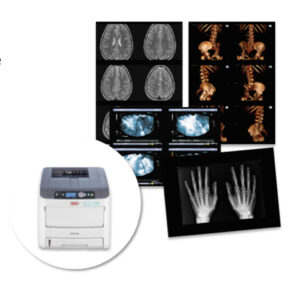How medical printing will add marketing value to sterile healthcare organisations?
Personalised medical imaging could increase patient satisfaction in the healthcare industry says Javier Lopez, General Manager, Vertical Solutions, OKI Europe Ltd

Going to the doctor can be daunting; waiting in a sterile reception surrounded by people feeling unwell just adds to your anxiety. Now imagine how much more daunting the experience would be if you were receiving abrupt, impersonal service.
Simple measures, such as a friendly, personal service make all the difference for patients and customers, and if those measures were reflected in the medical results and documentation supplied to patients, medical organisations could benefit from increased confidence and patient satisfaction. Businesses and healthcare organisations offering radiology services, such as cardiologists, gynaecologists, medicine centres and others with X-Ray facilities, must rely on medical imaging manufacturers to produce informative, easy-to-digest images. Not only are these essential in enabling medical staff to recognise medical complications and assert the best course of action, but they help patients understand complex issues that are often difficult to accept.
Building Patient Trust
For medical imaging manufacturers, there is a clear opportunity to help those radiology-based organisations build trust with their patients while reducing time spent describing those complex issues. Presenting patients with sharp, high-quality colour images will undoubtedly increase the ease of describing issues and treatments. For patients, this creates a friendlier more personalised and satisfying experience that will provide a valued level of comfort during an otherwise daunting experience.
The ease of integration between medical imaging equipment and DICOM printers, and the continuous evolution this communication standard has experienced over the years, has achieved a nearly universal level of acceptance among vendors of radiological equipment. However, the benefits of DICOM are only recognised by medical imaging manufacturers and medical staff. While this means that patients receive correct diagnoses and treatments, the benefits of actually being able to keep or reference DICOM printed images have not been experienced by patients, or clients of private medical businesses.
Traditionally, this has been due to the fact that DICOM image files are not easy to share with patients. While other image file formats such as JPEG, PNG or TIFF files are recognised and easily read by personal computers, DICOM files are not recognised by the standard home PC or laptop running Windows or iOS operating systems. While medical organisations could explore the option of sharing the images via email, the patient would require additional software in the form of a DICOM viewer to access the file, and even then, the patient would need additional information in the email content or in a separate text file to explain the findings in the image.
Personalising the Patient Experience
This is where medical imaging manufacturers can provide a simple yet effective solution in the form of personalised booklets, providing a referenceable take-home source of information for patients, including detailed, high-quality images. To maximise their marketing value, the booklets should include relevant information alongside the images, explaining the findings of the scan or X-Ray, or detailing proposed surgery in booklets that present visual renderings of potential cosmetic procedures.
Through variable data printing, the booklets can be further personalised with the patient’s name, surname and date of birth clearly displayed on the front cover. This level of personalisation will bolster patient confidentiality by ensuring medical staff pass the right documents to the correct patients. Linked reports and other relevant documentation, such as a post-diagnosis radiology report, can also be included, providing all of the relevant information for both doctor and patient in one easily referenceable booklet.
A patient requiring cosmetic surgery could be presented with an A3 colour booklet during the consultation stage, prior to making a decision on whether to go ahead with the surgery. Having the personalised booklet detailing the proposal of treatment, the course of surgery and follow-up treatment, including before and after images, will enable the patient to make an informed decision in their own time.
For patients requiring successive treatments for example for dental care, the personalised booklet will help to keep them up to date with the course of treatment, and new booklets printed periodically during the course of treatment will increase patient satisfaction by highlighting the patient’s progress on the road to recovery.
Personalised booklets will also be of great value to expecting parents, presenting high-quality ultrasound scans that will provide a lasting keepsake which can be shared with friends and family members.

For medical organisations, there is a clear opportunity to increase marketing value through increased satisfaction in a highly personalised experience. In turn, this creates a clear opportunity for medical imaging manufacturers that can provide high-quality personalised booklets in a flexible range of formats and sizes that include sharp, colourful images that will inform and placate medical patients in an age of high expectations.
















